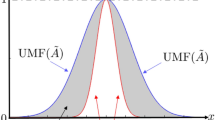Abstract
In this paper, based on the modified fuzzy c-regression model and noise clustering algorithm, a fuzzy identification method is proposed. Firstly, by considering the relations for the real model, the established model, and the outliers, a modified objective function with noise is proposed to alleviate the affection of noise. Additionally, the consequent parameters of the fuzzy model can be obtained by the iterative formula which obtained by the Lagrangian formula. Furthermore, a modified membership function, which is involved the likelihood function, is propounded to get a more suitable multivariate normal distribution for the data points. Lastly, two examples are illustrated to show the validity and effectiveness of the proposed results.






Similar content being viewed by others
Explore related subjects
Discover the latest articles, news and stories from top researchers in related subjects.References
Xu, C.: Decoupling correlated and uncorrelated parametric uncertainty contributions for nonlinear models. Appl. Math. Modell. 37(24), 9950–9969 (2000)
Tsai, S.H., Chen, Y.W.: A novel identification method for Takagi–Sugeno fuzzy model. Fuzzy Sets Syst. 338(1), 117–135 (2018)
Hasheminejad, S.A., Shabaab, M., Javadinarab, N.: Developing cluster-based adaptive network fuzzy inference system tuned by particle swarm optimization to forecast annual automotive sales: a case study in Iran market. Int. J. Fuzzy Syst. 37(23), 9591–9602 (2013)
Rathnayake, N., Dang, T.L., Hoshino, Y.: A novel optimization algorithm: cascaded adaptive neuro-fuzzy inference system. Int. J. Fuzzy Syst. 23, 1955–1971 (2021)
Sarkar, R., Kumar, J.R., Sridhar, R., Vidyasagar, S.: A new hybrid BAT-ANFIS-based power tracking technique for partial shaded photovoltaic systems. Int. J. Fuzzy Syst. 23, 1313–1325 (2021)
Tsai, S.H., Chen, Y.W.: A novel fuzzy identification method based on ant colony optimization algorithm. IEEE Access 4, 3747–3756 (2016)
Martins, J.B., Bertone, A.M.A., Yamanaka, K.: Novel fuzzy system identification: comparative study and application for data forecasting. IEEE Latin Am. Trans. 17(11), 1793–1799 (2019)
Santoso, F., Garratt, M.A., Anavatti, S.G., Hassanein, O., Stenhouse, T.: Novel fuzzy system identification: comparative study and application for data forecasting. IEEE/ASME Trans. Mechatron. 25(4), 2330–2341 (2020)
Hathaway, R.J., Bezdek, J.C.: Switching regression models and fuzzy clustering. IEEE Trans. Fuzzy Syst. 1(3), 195–204 (1993)
Tsai, S.H., Wang, J.W., Song, E.S., Lam, H.K.: Robust control for nonlinear hyperbolic PDE systems based on the polynomial fuzzy model. IEEE Trans. Cybernet. 51(7), 3789–3801 (2021)
Tsai, S.H., Jen, C.Y.: Stabilization for polynomial fuzzy time-delay system: a sum-of-squares approach. IEEE Trans. Fuzzy Syst. 26(6), 3630–3644 (2018)
Kim, E., Park, M., Ji, S., Park, M.: A new approach to fuzzy modeling. IEEE Trans. Fuzzy Syst. 5(3), 328–337 (1997)
Kung, C.C., Su, J.: Affine Takagi–Sugeno fuzzy modelling algorithm by fuzzy c-regression models clustering with a novel cluster validity criterion. IET Control Theory Appl. 1(5), 1255–1265 (2007)
Wang, L.X., Mendel, J.M.: Fuzzy basis functions, universal approximation, and orthogonal least squares learning. IEEE Trans. Neural Netw. 3(5), 807–814 (1992)
Dincer, N.G.: A new fuzzy time series model based on fuzzy \(c\)-regression model. Int. J. Fuzzy Syst. 25, 1872–1887 (2018)
Chuang, C.C., Jeng, J.T., Lin, W.Y., Hsiao, C.C., Tao, C.W.: Interval fuzzy \(c\)-regression models with competitive agglomeration for symbolic interval-valued data. Int. J. Fuzzy Syst. 256, 891–900 (2020)
Yan, C., Liu, Q., Liu, J., Liu, W., Li, M., Qi, M.: Payments per claim model of outstanding claims reserve based on fuzzy linear regression. Int. J. Fuzzy Syst. 89, 1950–1960 (2019)
Choi, S.H., Jung, H.Y., Kim, H.: Ridge fuzzy regression model. Int. J. Fuzzy Syst. 8, 2077–2090 (2019)
Gong, Y., Yang, S., Ma, H., Ge, M.: Fuzzy regression model based on Incentre distance and application to employee performance evaluation. Int. J. Fuzzy Syst. 7, 2632–2639 (2018)
Soltani, M., Chaari, A., Hmida, F.B.: A novel fuzzy \(c\)-regression model algorithm using a new error measure and particle swarm optimization. AMCS Int. J. Appl. Math. Comput. Sci. 11(3), 617–628 (2012)
Dave, R.N.: Characterization and detection of noise in clustering. Pattern Recognit. Lett. 12(11), 657–664 (1991)
Li, C., Zhou, J., Xiang, X., Li, Q., An, X.: T–S fuzzy model identification based on a novel fuzzy c-regression model clustering algorithm. Eng. Appl. Artif. Intell. 22(4), 646–653 (2009)
Canova, A., Gruosso, G., Repetto, M.: Magnetic design optimization and objective function approximation. IEEE Trans. Magn. 39(5), 2154–2162 (2003)
Li, C., Zhou, J., Li, Q., An, X., Xiang, X.: A new T–S fuzzy-modeling approach to identify a boiler-turbine system. Expert Syst. Appl. 37(3), 2214–2221 (2010)
Zou, W., Li, C., Zhang, N.: A T-S Fuzzy Model Identification Approach Based on a Modified Inter Type-2 FRCM Algorithm. IEEE Trans. Fuzzy Systems 26(3), 1104–1113 (2018)
Duan, J.C., Chung, K.: Multilevel fuzzy relational systems: structure and identification. Soft Comput. 6(2), 71–86 (2002)
Guo, F., Lin, L., Xie, X., Luo, B.: Novel hybrid rule network based on T–S fuzzy rules. Neural Netw. World 25(1), 93–116 (2015)
Jang, J.R., Sun, C.T., Mizutani, E.: Neuro-fuzzy and soft computing: a computational approach to learning and machineintelligence. IEEE Trans. Auto. Control 42(10), 1482–11484 (1997)
Nauck, D., Kruse, R.: Neuro-fuzzy systems for function approximation. IEEE Trans. Fuzzy Syst. 101(2), 261–271 (1997)
Masoumi, M., Khanjani, M.J., Qaderi, K.: Uplift capacity prediction of suction caisson in clay using a hybrid intelligence method (GMDH-HS). Appl. Ocean Res. 59, 408–416 (2016)
Narendra, K.S., Parthasarathy, K.: Identification and control of dynamical systems using neural networks. IEEE Trans. Neural Netw. 1(1), 4–27 (1990)
Cheung, N.J., Ding, X., Shen, H.B.: OptiFel: a convergent heterogeneous particle swarm optimization algorithm for Takagi–Sugeno fuzzy modeling. IEEE Trans. Fuzzy Syst. 22(4), 919–933 (2014)
Li, C., Zhou, J., Chang, L., Huang, Z.J., Zhang, Y.: T–S fuzzy model identification based on a novel hyperplane-shaped membership function. IEEE Trans. Fuzzy Syst. 25(5), 1364–1370 (2017)
Dam, T., Deb, A.K.: A clustering algorithm based TS fuzzy model for tracking dynamical system data. J. Frankl. Inst. 134(13), 5617–5645 (2017)
Acknowledgements
This research was funded by Ministry of Science and Technology, Taiwan, under grants MOST-110-2221-E-110-067 and MOST-111-2221-E-110-061.
Author information
Authors and Affiliations
Corresponding author
Rights and permissions
About this article
Cite this article
Tsai, SH., Chen, YT. A Fuzzy Identification Method Based on the Likelihood Function and Noise Clustering Algorithm. Int. J. Fuzzy Syst. 25, 136–144 (2023). https://doi.org/10.1007/s40815-022-01366-0
Received:
Revised:
Accepted:
Published:
Issue Date:
DOI: https://doi.org/10.1007/s40815-022-01366-0




